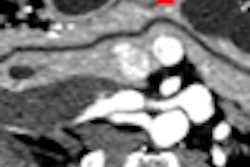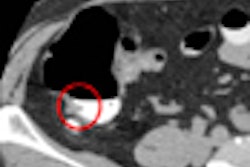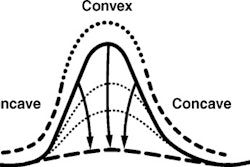A new coronary calcium scoring method known as calcium coverage score (CCS) is a significant predictor of cardiac events compared to standard scoring methods, according to researchers from several academic centers in the U.S.
In contrast, neither the Agatston calcium score nor the mass score was a significant predictor of events in the study model, which suggests that calcium distribution in the coronary arteries may be more important than the total calcium burden, though both contribute to the risk of cardiac events.
High-resolution CT scanning of the heart allows precise determination of calcified regions within the coronary arteries, however, "Few investigators have used this feature to describe the spatial distribution of calcified plaques," wrote Elizabeth R. Brown, Sc.D., from the University of Washington in Seattle, along with colleagues at Johns Hopkins University, Baltimore; Wake Forest University Health Sciences, Winston-Salem, NC; and the UCLA School of Medicine in Los Angeles (Radiology, June 2008, Vol. 247:3, pp. 669-675).
"Although the presence and amount of calcific plaque as measured with the Agatston score are known to be associated not only with demographic factors and risk factors but also with cardiovascular events, information about the spatial distribution of calcific plaque might provide additional insight into the pathogenesis of coronary atherosclerosis and the risk of cardiovascular events," they wrote.
The study aimed to develop a new scoring model that could be used to define the percentage of coronary arteries affected by calcium, and correlate the score with risk factors and adverse events.
The researchers calculated CCS, which represents the percentage of coronary arteries affected by calcified plaque, for all 3,252 participants in the Multi-Ethnic Study of Atherosclerosis (MESA).
The MESA trial scanned 6,814 men and women ages 45 to 84 years twice using either electrocardiographically triggered electron-beam CT (Imatron C-150, GE Healthcare, Chalfont St. Giles, U.K.) or prospective electrocardiographic triggering MDCT scanners (LightSpeed 16, GE Healthcare, or Volume Zoom, Siemens Healthcare, Malvern, PA) used in two of six centers. All patients were scanned at 80% of the RR interval, with the results read by experienced readers.
The researchers interviewed patients by telephone for detailed information regarding risk factors and demographics. Participants were followed for a median of 41 months (range, 0 to 64 months) and asked about physician visits and cardiovascular events, with answers verified by provider institutions. Demographics and risk factors were also compared among the 3,416 participants without detected calcified plaque.
"On average, participants had 50% of their calcific plaque in the proximal 15% (approximately 15 mm) of their LCX [left circumflex] coronary artery. However, on average, participants had 50% of their calcific plaque in the proximal 25 mm of their LM [left main] and LAD [left anterior descending] coronary arteries and RCA [right coronary artery]," Brown and her team found.
The distribution of calcified plaque was more diffuse in the RCA than in the LM and LAD or LCX arteries, they added. The median CCS was 5.3% (range, 1.0% to 63.6%).
After adjusting for participants' age, race ethnicity, and sex in the quasi-Poisson model, the calcium coverage score was found to be associated with hypertension, dyslipidemia, and diabetes (p < 0.001 for all diseases), which had the strongest association with CCS, the authors reported.
The calcium coverage ratio for participants with diabetes compared to those without the disease was 1.44, showing that in diabetic patients an average of 44% more of the coronary artery tree was affected by calcified plaque compared to patients without diabetes.
The calcium coverage scores decreased dramatically but were still significant when either the Agatston score or the mass score was included as a predictor with the risk factors.
"For example, among participants with the same Agatston score or mass score, calcific plaque will affect 5% more of the arterial length in patients with diabetes than in patients without diabetes (p < 0.02)," the researchers wrote. "Similar values for participants with dyslipidemia and hypertension were 5% and 6%, respectively (p < 0.01)."
However, when either Agatston or mass scores were included in calcium coverage scores for the prediction of events, neither measure was a significant predictor, "whereas CCS remained significantly associated with CHD [coronary heart disease] events," they wrote.
For all coronary heart disease events, the area under the curve (AUC) for calcium coverage score (0.70) was significantly higher than the Agatston (p = 0.003) or the mass score (p = 0.006). For hard coronary events, however, there was no significant difference between the AUC for the CCS and that of the Agatston score (p = 0.076) or between the AUC for the CCS and the AUC for the mass score (p = 0.81).
The results were similar to a study by Eggen et al of 349 autopsy specimens, which found a maximum coronary plaque deposition of approximately 20 mm, with a more pronounced peak in the LAD and a more uniform distribution in the RCA, Brown and colleagues wrote.
Among its limitations, the CCS method depends on the operator accurately tracing the arteries along their entire length, potentially increasing reading time while adding an element of variability to the results. This rendered the method slightly less reproducible with regard to intraclass coefficients versus other scoring methods, they noted, and no correlation was found between CCS and "hard" cardiac events.
The results show that spatial distribution of calcified plaque "is an important component of coronary atherosclerosis above and beyond the overall amount of calcium and the calcium density," Brown et al concluded. "In particular, the CCS enabled us to rank participants in terms of prediction of cardiovascular events better than did Agatston or mass scores. Calcium measurement techniques that directly incorporate the spatial distribution of calcium may help our understanding of the relationship between calcified plaque and cardiovascular events. The CCS provides evidence that incorporation of the higher order information concerning plaque location is important in predicting cardiovascular events."
The study paves the way to better prognostic calculations by combining measures of plaque burden with location, and the initial results should be validated in other populations and studies.
"We expect that this score will prove to be useful in the clinical setting by helping physicians to classify patients according to risk more accurately than with use of the Agatston or mass scores and thereby devise improved individual treatment strategies," the authors wrote.
By Eric Barnes
AuntMinnie.com staff writer
June 16, 2008
Related Reading
Coronary calcium still matters, May 26, 2008
Incidental findings on cardiac MDCT common for healthy adults, May 9, 2008
Cardiac CT saves money and time as first-line heart test, April 1, 2008
Coronary calcium score predicts coronary events in 4 major ethnic groups, March 28, 2008
Coronary artery calcium suggests abnormal myocardial perfusion, February 12, 2008
Copyright © 2008 AuntMinnie.com



















